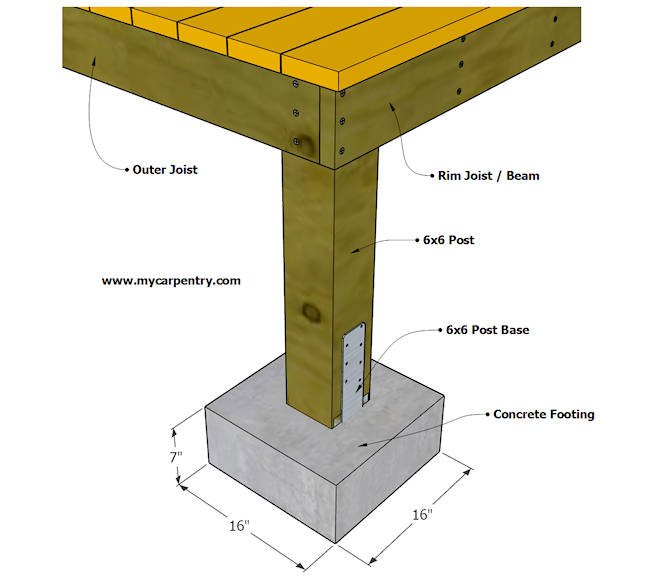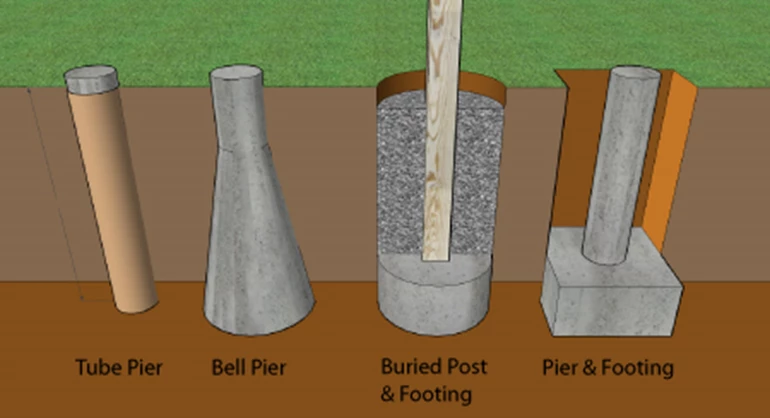From Principle to Concrete: The Vital Duty of Deck Footings in Sturdy and Safe Decks
From Principle to Concrete: The Vital Duty of Deck Footings in Sturdy and Safe Decks
Blog Article
Selecting the Right Deck Footings for Stability and Resilience
The long life and security of your deck depend heavily on the type of grounds you select, as they give the crucial assistance and security to withstand the test of time. In this discussion, we will certainly discover the different types of deck grounds, think about the essential aspects to weigh when making a decision, and dive into the pros and disadvantages of different choices.
Sorts Of Deck Footings
These grounds are composed of a cylindrical hole filled up with concrete, which gives a solid structure for the deck messages. Concrete pier grounds are relatively simple to set up and provide excellent security, making them a prominent selection for numerous deck jobs.
Another sort of footing is the helical stack footing. Helical heaps are steel shafts with helical plates affixed to them. These footings are mounted by screwing them right into the ground, which develops a safe structure for the deck. Helical pile footings are suitable for areas with difficult dirt problems, as they can be set up in practically any kind of type of soil. If required., they additionally permit for simple adjustment and progressing of the deck.
Additionally, some builders select precast concrete footings. These grounds are constructed from sturdy concrete and be available in various sizes and shapes to accommodate various deck styles. Precast concrete footings are practical to set up and supply a secure base for the deck structure.
Ultimately, another choice is the post-in-anchor ground system. This sort of ground involves driving a metal anchor right into the ground and affixing it to the deck post. It uses adaptability in terms of positioning the deck posts and appropriates for decks with light-weight structures.
When choosing the appropriate kind of deck footing, it is important to take into consideration variables such as dirt conditions, deck tons, and regional building regulations (Deck Footings). Consulting with a specialist specialist or structural engineer can aid make certain the proper footing is selected for a risk-free and stable deck
Variables to Take Into Consideration When Choosing Footings
When selecting the ideal grounds for a deck, it is critical to carefully take into consideration various elements such as soil problems, deck lots, and adherence to local building ordinance. These variables play a substantial role in ensuring the security and resilience of the deck framework.
One of the primary factors to think about is the soil problems. The kind of soil on which the deck will be constructed identifies the sort of grounds called for. Decks built on sandy or loose soils might require much deeper footings to give appropriate assistance and prevent settling. On the other hand, decks built on clay or expansive dirts might call for grounds that can accommodate the dirt's tendency to broaden and contract.
Another important factor is the deck lots. The weight of the deck, including the materials utilized and any kind of prospective live tons such as furnishings or events, need to be considered when selecting footings. The grounds should be created to birth the weight of the deck and disperse it equally to stop any kind of architectural issues or failings.
Last but not least, adherence to neighborhood building regulations is extremely important. Building ordinance vary from region to area, and it is important to abide with the specific needs established by the regional authorities. Deck Footings. These codes make certain that the deck is built safely and meets the necessary standards for structural stability and load-bearing capacity
Concrete Footings: Disadvantages and pros

Concrete grounds offer several benefits and disadvantages when utilized as the foundation for a deck. On the positive side, concrete grounds give superb security and sturdiness.
Another benefit of concrete footings is their flexibility. internet They can be poured into various sizes and shapes to suit numerous deck layouts and arrangements. Concrete footings can be tailored to fit the particular needs and demands of the deck framework.
Nevertheless, there are also some drawbacks to making use of concrete footings. This can boost the total cost of the deck task and might call for expert help.

Helical Piers Vs. Sonotubes: Which Is Much better?
In thinking about the structure options for a deck, the comparison in between helical piers and sonotubes is vital in determining the exceptional selection. They are twisted into the ground utilizing hydraulic equipment, supplying a sturdy and secure foundation for the deck.
The helical plates on the piers create a solid grasp with the dirt, protecting against any activity or shifting of the deck. Sonotubes, on the other hand, depend solely on the concrete loading for security, which may her latest blog not supply the exact same level of stamina and resistance.
In terms of setup, helical piers are reasonably simpler and faster to set up contrasted to sonotubes. The hydraulic equipment made use of to twist the piers right into the ground makes sure a quick and efficient procedure. Sonotubes, on the other hand, require excavating openings and pouring concrete, which can be labor-intensive and time-consuming.
Additionally, helical piers are an even more flexible option. If needed, they can be utilized in numerous dirt conditions and can be changed or enhanced. Sonotubes, on the other hand, might need added assistance, such as rebar, in particular soil conditions or areas with high load needs.
Selecting the Right Footings for Your Deck's Measurements
For ideal structural honesty, it is vital to thoroughly pick the suitable footings that align with the dimensions of your deck. The measurements of your deck, including its length, size, and height, play a considerable duty in establishing the type and dimension of footings needed.
When choosing footings for your deck, it is essential to consider the load-bearing capacity of the soil. The weight of the deck, integrated with the weight of any kind of furnishings or people on it, puts in a significant pressure on the footings (Deck Footings). It is vital to select footings that can properly sustain this weight without shifting or sinking over time.
Larger decks with better measurements call for bigger grounds to provide sufficient stability and assistance. The form of the grounds, whether they are round or square, depends on the layout and format of the deck.
Verdict
In conclusion, choosing the best deck footings is crucial for making certain security and resilience. Aspects such as the kind of footings, the deck's measurements, see page and the pros and cons of different choices should be taken into consideration.
These footings consist of a round hole loaded with concrete, which offers a strong structure for the deck articles. Concrete pier grounds are fairly easy to install and provide exceptional security, making them a popular option for numerous deck jobs.
Precast concrete grounds are practical to mount and offer a secure base for the deck structure.
It uses flexibility in terms of positioning the deck articles and is ideal for decks with light-weight structures.
Concrete footings use several benefits and disadvantages when utilized as the structure for a deck.
Report this page